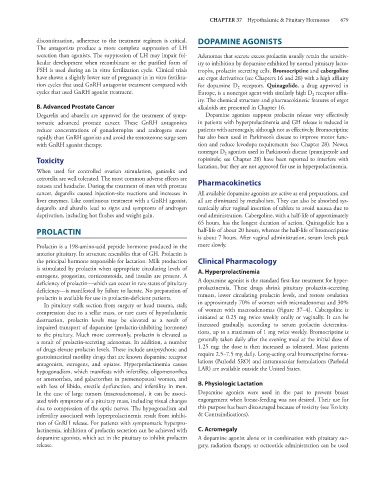Page 693 - Basic _ Clinical Pharmacology ( PDFDrive )
P. 693
CHAPTER 37 Hypothalamic & Pituitary Hormones 679
discontinuation, adherence to the treatment regimen is critical. DOPAMINE AGONISTS
The antagonists produce a more complete suppression of LH
secretion than agonists. The suppression of LH may impair fol- Adenomas that secrete excess prolactin usually retain the sensitiv-
licular development when recombinant or the purified form of ity to inhibition by dopamine exhibited by normal pituitary lacto-
FSH is used during an in vitro fertilization cycle. Clinical trials trophs, prolactin secreting cells. Bromocriptine and cabergoline
have shown a slightly lower rate of pregnancy in in vitro fertiliza- are ergot derivatives (see Chapters 16 and 28) with a high affinity
tion cycles that used GnRH antagonist treatment compared with for dopamine D receptors. Quinagolide, a drug approved in
2
cycles that used GnRH agonist treatment. Europe, is a nonergot agent with similarly high D receptor affin-
2
ity. The chemical structure and pharmacokinetic features of ergot
B. Advanced Prostate Cancer alkaloids are presented in Chapter 16.
Degarelix and abarelix are approved for the treatment of symp- Dopamine agonists suppress prolactin release very effectively
tomatic advanced prostate cancer. These GnRH antagonists in patients with hyperprolactinemia and GH release is reduced in
reduce concentrations of gonadotropins and androgens more patients with acromegaly, although not as effectively. Bromocriptine
rapidly than GnRH agonists and avoid the testosterone surge seen has also been used in Parkinson’s disease to improve motor func-
with GnRH agonist therapy. tion and reduce levodopa requirements (see Chapter 28). Newer,
nonergot D agonists used in Parkinson’s disease (pramipexole and
2
Toxicity ropinirole; see Chapter 28) have been reported to interfere with
lactation, but they are not approved for use in hyperprolactinemia.
When used for controlled ovarian stimulation, ganirelix and
cetrorelix are well tolerated. The most common adverse effects are
nausea and headache. During the treatment of men with prostate Pharmacokinetics
cancer, degarelix caused injection-site reactions and increases in All available dopamine agonists are active as oral preparations, and
liver enzymes. Like continuous treatment with a GnRH agonist, all are eliminated by metabolism. They can also be absorbed sys-
degarelix and abarelix lead to signs and symptoms of androgen temically after vaginal insertion of tablets to avoid nausea due to
deprivation, including hot flushes and weight gain. oral administration. Cabergoline, with a half-life of approximately
65 hours, has the longest duration of action. Quinagolide has a
PROLACTIN half-life of about 20 hours, whereas the half-life of bromocriptine
is about 7 hours. After vaginal administration, serum levels peak
Prolactin is a 198-amino-acid peptide hormone produced in the more slowly.
anterior pituitary. Its structure resembles that of GH. Prolactin is
the principal hormone responsible for lactation. Milk production Clinical Pharmacology
is stimulated by prolactin when appropriate circulating levels of A. Hyperprolactinemia
estrogens, progestins, corticosteroids, and insulin are present. A
deficiency of prolactin—which can occur in rare states of pituitary A dopamine agonist is the standard first-line treatment for hyper-
deficiency—is manifested by failure to lactate. No preparation of prolactinemia. These drugs shrink pituitary prolactin-secreting
prolactin is available for use in prolactin-deficient patients. tumors, lower circulating prolactin levels, and restore ovulation
In pituitary stalk section from surgery or head trauma, stalk in approximately 70% of women with microadenomas and 30%
compression due to a sellar mass, or rare cases of hypothalamic of women with macroadenomas (Figure 37–4). Cabergoline is
destruction, prolactin levels may be elevated as a result of initiated at 0.25 mg twice weekly orally or vaginally. It can be
impaired transport of dopamine (prolactin-inhibiting hormone) increased gradually, according to serum prolactin determina-
to the pituitary. Much more commonly, prolactin is elevated as tions, up to a maximum of 1 mg twice weekly. Bromocriptine is
a result of prolactin-secreting adenomas. In addition, a number generally taken daily after the evening meal at the initial dose of
of drugs elevate prolactin levels. These include antipsychotic and 1.25 mg; the dose is then increased as tolerated. Most patients
gastrointestinal motility drugs that are known dopamine receptor require 2.5–7.5 mg daily. Long-acting oral bromocriptine formu-
antagonists, estrogens, and opiates. Hyperprolactinemia causes lations (Parlodel SRO) and intramuscular formulations (Parlodel
hypogonadism, which manifests with infertility, oligomenorrhea LAR) are available outside the United States.
or amenorrhea, and galactorrhea in premenopausal women, and
with loss of libido, erectile dysfunction, and infertility in men. B. Physiologic Lactation
In the case of large tumors (macroadenomas), it can be associ- Dopamine agonists were used in the past to prevent breast
ated with symptoms of a pituitary mass, including visual changes engorgement when breast-feeding was not desired. Their use for
due to compression of the optic nerves. The hypogonadism and this purpose has been discouraged because of toxicity (see Toxicity
infertility associated with hyperprolactinemia result from inhibi- & Contraindications).
tion of GnRH release. For patients with symptomatic hyperpro-
lactinemia, inhibition of prolactin secretion can be achieved with C. Acromegaly
dopamine agonists, which act in the pituitary to inhibit prolactin A dopamine agonist alone or in combination with pituitary sur-
release. gery, radiation therapy, or octreotide administration can be used

